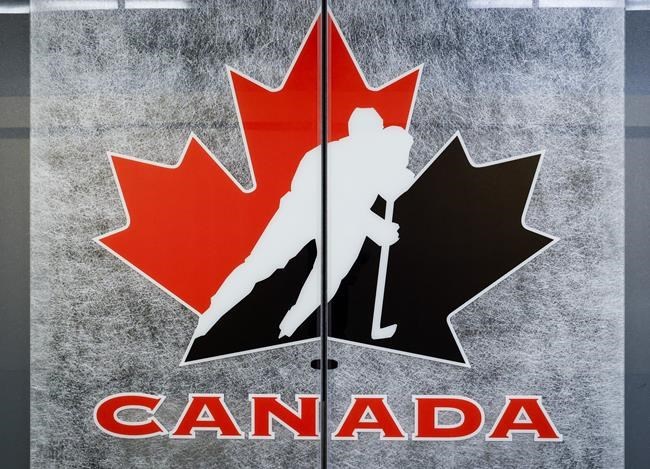TORONTO — Hockey Canada says a new independent third-party complaint mechanism received information on almost 1,900 potential cases of maltreatment during its first season.
The data is contained in the national sport organization's latest report on the issue — which covers abuse, discrimination and harassment — released Thursday as part of its numbers-based push to address the problem across the game.
Hockey Canada says of the 1,872 complaints made during the 2022-23 season, 187 were accepted and fully processed, while more than 1,400 didn't meet the threshold of severity to move forward and were redirected to provincial or territorial members for assessment.
Put differently, that's an average of nearly one complaint per 200 players across the country.
Of the accepted complaints, the report entitled "Tracking Maltreatment in Sanctioned Hockey" showed that 50.3 per cent involved bullying and harassment, followed by sexual maltreatment (19.8 per cent), physical abuse (11.2 per cent), discrimination (7.5 per cent) and abuse of power (seven per cent).
"(The report) is critical in our efforts to identify and take action against egregious behaviours that have no place in hockey and sport in general," Natasha Johnston, Hockey Canada's vice-president of sport safety, said in a statement.
"We will continue to be transparent in publicly sharing the data we collect with our members and use the insights to better inform our collective actions moving forward."
The report's release comes as Hockey Canada continues to recover from the dramatic fallout of alleged sexual assaults involving members of both the 2018 and 2003 world junior teams that shook the sport in this country to its core. None of the allegations have been proven in court.
Hockey Canada had 550,137 registered players in 2022-23, but participants in the top-tier Canadian Hockey League, including the WHL, OHL and QMJHL, along with those at the adult recreation level were not included in the report.
That brought the total number down to 480,680 players.
Of the 1,872 complaints received by the independent third party, the report stated 1,057 were made by a family member or guardian, while 598 came from a hockey association.
"The mechanisms used to track maltreatment are newly developed and have been recently refined," the report read. "Tracking systems throughout the hockey ecosystem will continue to improve, which will improve the accuracy of reporting over time."
Hockey Canada's report defines maltreatment as a "wilful act and/or omission that results in or has the potential for physical or psychological harm." It can be psychological, physical, neglectful or sexual in nature, and can also include bullying, harassment and discrimination.
The report stated there were 1,624 documented or alleged incidents of on-ice discrimination last season, up from the 927 contained in Hockey Canada's initial maltreatment report related to 2021-22.
Officials called 913 penalties in 2022-23 related to Rule 11.4 — which deals specifically with discrimination, including race, language, religion, sexual orientation, gender identity/expression, genetic characteristics and disability — compared to 512 infractions the previous season.
The average number of Rule 11.4 penalties in 2021-22 stood at 1.13 per 1,000 players, while 2022-23 saw 1.90 per 1,000 players for an increase of about 68 per cent.
When it came to allegations that weren't witnessed by an official and required an investigation, there were 0.91 penalties per 1,000 players (415 total) in 2021-22 compared to 1.48 per 1,000 players (711 total) in 2022-23 for an increase of roughly 63 per cent.
Sexual orientation/gender identity were by far the most common types of discrimination over the last two seasons, with the under-18 and under-15 age divisions seeing the overwhelming majority of infractions.
Hockey Canada pointed to improved awareness, education and reporting processes as potential reasons for the overall increases.
The 18-page report also showed that the third-party Office of the Sport Integrity Commissioner received 25 complaints or reports related to hockey, although 24 were deemed inadmissible and one was pending as of June 30, 2023.
The report stated an alternative option was identified by the OSIC in 16 of the 24 inadmissible cases, while 15 were referred to another body.
Hockey Canada became a full signatory of the government-backed Abuse-Free Sport program in October 2022.
"We are committed to expanding reporting on maltreatment in sanctioned hockey during the 2023-24 season as well as working to prevent and address maltreatment behaviours in sanctioned hockey programming," Johnson's statement read.
"As we continue to build greater awareness and facilitate greater opportunities and trust for individuals to come forward, it is anticipated that there will be an increase in maltreatment incidences being reported on and off the ice."
This report by The Canadian Press was first published Nov. 30, 2023.
___
Follow @JClipperton_CP on X.
Joshua Clipperton, The Canadian Press



